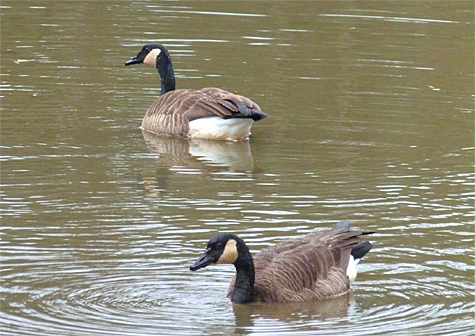First, let’s talk about the name. The common, and proper, name for the big brown goose with the long black neck and white chin is Canada Goose. A Canada Goose may indeed be Canadian, but they may also be American, it all depends upon which side of the US/Canada border it was hatched. The geese we have in our Wetlands are most assuredly American in origin, they were certainly hatched here in North Carolina. Their species name is Canada Goose but they are American Canada Geese. It’s a common mistake for people to call them Canadian Geese. At one time (pre-1980) it may have been correct, in part, to call them Canadian Geese since the geese that were seen here at the time were most likely migrants from Canada. That has changed.
Most, if not all, of the geese that we see here in and around Durham have probably never seen Canada. The vast majority of migrant Canada Geese in our state winter on or near the northeast coast, near Mattamuskeet, Pungo, Pocosin, and other refuges down east, or at the Pee Dee National Wildlife Refuge near Charlotte in North Carolina. The rest of the geese are permanent residents, born and raised North Carolinians.

Back in the 1980s, the number of migrant Canada Geese here in North Carolina had been steadily decreasing from their peak period in the 1940s, for various reasons. To help counter that decrease the thought among some wildlife folks was to import a subspecies of Canada Goose that, genetically, had few migratory aspirations. The geese would stay put, move around some, but they wouldn’t leave the state in spring. They would live and nest right here year round.
Well, it worked. Today the geese can be seen in city parks, golf courses, and at small ponds and rivers throughout the state. It was quite a shock for me the first time that I saw a Canada Goose nesting here. I was canoeing down the Eno River during the hot and humid late spring and there, around the bend on a small island smack in the middle of the river, was a goose sitting on a nest.
This was a bird I had always associated with cool weather, fall and winter. I wasn’t used to seeing Canada Geese while I was wearing shorts and sweating profusely, it was way beyond the realm of normalcy. I had only been in North Carolina a short time (1991) and didn’t realize that there was a resident population of Canadas here.
There is a love-hate relationship with local Canada Geese in most places that they now reside. They’re neat to look at, and it’s inspiring to see and hear them fly over in the mornings and evenings when they’re commuting to and from their nighttime roosts and daytime pastures or ponds. But, greenskeepers hate them, city park picnickers feel pretty much the same, and owners of small freshwater ponds are usually not very fond of the flocks that come into their little plots of paradise.
Why? Because they, the geese, leave behind long stings or splats of green feces wherever they go. Golfers don’t like to putt around or through goose poop, most people don’t like to step in goose poop or lay down a picnic blanket on it either, and too much goose fecal matter in a small fish pond can turn it into an algae clogged mess. Wherever the geese go they have a tendency to make the place quite untidy in short order.
Whether you personally like the geese or not, though, they are locally grown and they are here to stay. You can rest assured that the geese you see flying across the sunset on your drive home from work, peacefully grazing on the fairway as you chip out of the rough, or swimming in the local pond, were hatched here. Some people call our resident, local geese “Giant Canada Geese” or “Resident Canada Geese,” but whatever you call them, they are Carolinians, Americans, and Canada Geese all at the same time, but they’re not Canadian.
Incidentally, their Latinized name, or scientific name, is Branta canadensis, which means “goose from Canada.” The subspecies that was introduced to our area is Branta canadensis maxima, which means “greatest,” or “largest goose from Canada.” They are the largest of the seven subspecies of Canada Geese. They can weigh more than twenty pounds, averaging about 12, and can live as long as 30 years. And this fun fact from National Geographic sums up some people’s overall view of the geese, “Just 50 geese can produce two and a half tons of excrement in a year.” Not sure where Nat Geo got their figures, but when you think about it, that number seems a bit low.
I personally enjoy this particular pair of Canada geese when they come to visit every year. They walk around like they own the place, and the male is solicitously protective of the female in an endearing, old school way.
Yes, I enjoy their visits as well. They are not at all skittish, cautious but not skittish, which affords lots of kids an opportunity to get close looks at them.
Thanks,